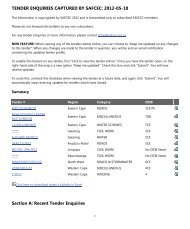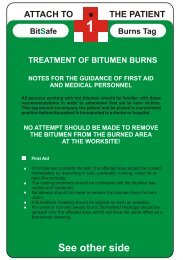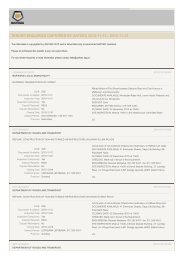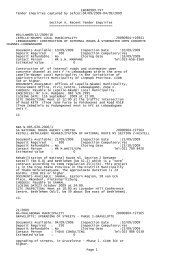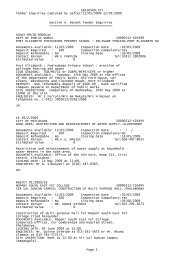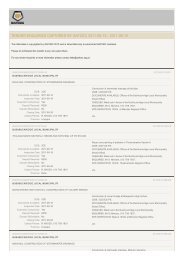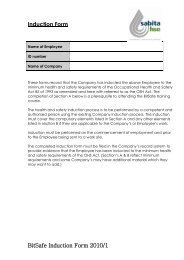DIGEST 2006 - Sabita
DIGEST 2006 - Sabita
DIGEST 2006 - Sabita
Create successful ePaper yourself
Turn your PDF publications into a flip-book with our unique Google optimized e-Paper software.
delays because of traffic diversion<br />
or pre-laying preparation of the<br />
road, the asphalt is often unusable<br />
when the time comes for it to be<br />
laid. The road authority frequently<br />
has to allow for losses of up to<br />
10% – even in the very warm<br />
months.<br />
The trial asphalt was<br />
manufactured with a 320 viscosity<br />
grade bitumen (similar to<br />
penetration grade 40/60),<br />
modified with 1.5% FT wax, and<br />
was loaded into the trucks at<br />
180 0 C. It was covered using a<br />
heat shield sheet laid over the top<br />
of the asphalt, together with three<br />
layers of carpet under-felt, and<br />
finally the usual tarpaulin covers.<br />
The first truck arrived at<br />
approximately<br />
10h30 after a 9.5<br />
hour drive. On<br />
arrival the asphalt<br />
temperatures at the<br />
side walls were as<br />
low as 112 0 C, while<br />
the surface and<br />
core temperatures<br />
were in the region<br />
of 130 0 C and<br />
160 0 C, respectively.<br />
Although the trial<br />
was planned for a<br />
very hot day it had rained the day<br />
before, and the ambient<br />
temperature was only 24 0 C in the<br />
morning.<br />
The road was profiled and cleaned,<br />
and paving then began as usual<br />
with a 25mm layer. During the<br />
laying operation the temperature<br />
of the asphalt dropped to 100 0 C<br />
on the sides of the paver (surface<br />
temperature), with the<br />
Total haulage<br />
times of up to<br />
12 hours<br />
before the<br />
asphalt could<br />
be loaded into<br />
the paver<br />
temperature in the middle being in<br />
the region of 135 0 C. The ambient<br />
temperature at this time was<br />
about 30 0 C.<br />
After the asphalt had been laid the<br />
edges were hand-worked to<br />
smooth them off, and a vibratory<br />
roller was used to compact the<br />
asphalt. Once the road had<br />
reached a surface temperature in<br />
the region of 65 0 C, a 17 ton<br />
pneumatic roller was used with a<br />
coverage of 6 passes to complete<br />
the compaction. The road surface<br />
temperature after finishing was<br />
approximately 45 0 C. After a few<br />
minutes the road was opened to<br />
traffic and the other half of the<br />
road was tackled. Total elapsed<br />
time from profiling until the road<br />
was opened to traffic was 2.75<br />
hours.<br />
The second truck<br />
carrying the next<br />
two loads of asphalt<br />
had been waiting<br />
for a few hours,<br />
resulting in a total<br />
transit time of<br />
approximately 12<br />
hours before the<br />
asphalt was loaded<br />
into the paver. This<br />
asphalt temperature<br />
in the truck had reached as low as<br />
100 0 C near the side walls, and was<br />
115 0 C and 135 0 C at the surface<br />
and core respectively.<br />
Construction proceeded as with<br />
the previous lane, and only a few<br />
lumps of asphalt (150 kg) were<br />
found to be unusable.<br />
In the cases mentioned above, the<br />
asphalt was laid as if in close<br />
proximity to the plant, and was<br />
93



